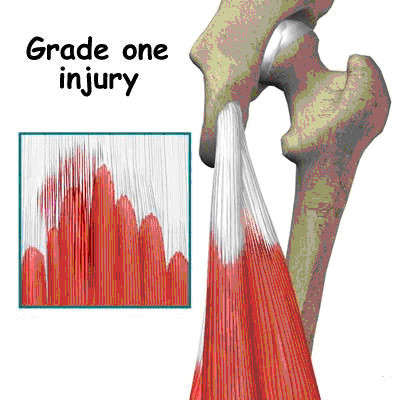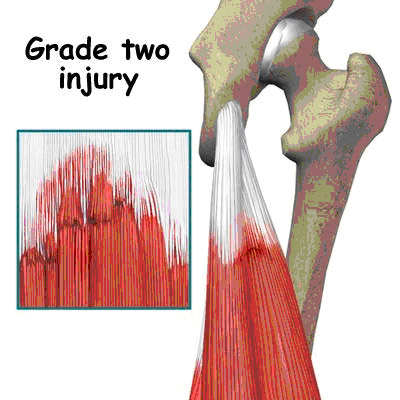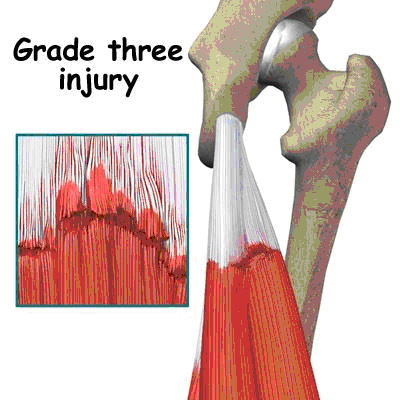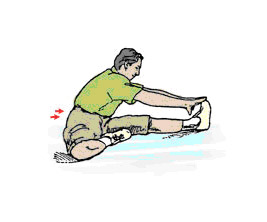Hamstring Muscle Strain
Any one who watches sports knows that a "pulled hamstring" is a troublesome and sometimes painful condition for athletes. The hamstrings are the muscles at the back of your thigh. These muscles help to straighten (extend) the leg at the hip and bend (flex) the leg at the knee. A "pulled" hamstring is a strain or tear in the muscles or tendons.

Anyone can experience hamstring strain, but most people at risk for this injury are:
- Adolescent athletes who are still growing
- Professional athletes (football, soccer, skating, or running)
- Runners or sprinters
- Dancers
- Older athletes whose exercise program is primarily walking
Causes
Hamstring injuries are easier to prevent than cure. But to understand what causes a hamstring injury, you first have to know how muscles work.
How Muscles Work
All muscles work in pairs to perform a task. One set of muscles shortens (contracts) to exert force, while the other set of muscles relaxes. The hamstring muscles, located at the back of the thigh, work with the quadriceps muscles in the front of the thigh. When you bend your leg, the hamstring muscles contract and the quadriceps muscles relax. Conversely, when you straighten your leg, the quadriceps muscles contract and the hamstring muscles relax.
Strains and Tears
When one muscle group is much stronger than its opposing muscle group, the imbalance can lead to a strain. This frequently happens with the hamstring muscles. The quadriceps muscles are usually much more powerful, so the hamstring may become fatigued faster than the quadriceps. A fatigued muscle cannot relax as easily when its opposing muscle contracts, leading to strains.
Muscle strains are overuse injuries that result when the muscle is stretched without being properly warmed up. It's like pulling a rubber band too long. Eventually, the rubber band will either lose its shape or tear apart. The same thing happens with muscles.
Hamstring strain in young people often occurs because bones and muscles do not grow at the same rate. During a growth spurt, the bones may grow faster than the muscles. The growing bone pulls the muscle tight, and a sudden jump, stretch, or impact can tear the muscle away from its connection to the bone.
Sometimes, a muscle that tears away from a bone will pull a piece of bone with it. This is called an avulsion injury. If the hamstring tears near the hip, where it attaches to the pelvis, it may pull a piece of hip bone (ischium) away. This is a serious injury that may require surgery to reattach the muscle.

Diagnosis
Hamstring injuries are usually readily apparent.
- Mild strains may involve a simple tightening of the muscle that you can feel.
- More severe injuries may result in a sharp pain in the back of the thigh, usually in full stride.
- A rupture or tear may leave you unable to stand or walk. The muscle may be tender to the touch, and it may be painful to stretch your leg. Within a few days after a tear, bruising may appear.
- In some cases , you will be required to do Magnetic resonance imaging (MRI) . An MRI scan is a special radiological test that uses magnetic waves to create pictures that look like slices of the hamstring. The MRI scan is painless and requires no needles or special dye.
Hamstring injuries are grouped into three categories.
- Grade one - mild
- Grade two - moderate
- Grade three - severe



Grade one injuries are muscle pulls that do not result in much damage to the structure of the tissues. Grade two injuries are partial tears. Grade three injuries are complete tears.
Treatment
Nonsurgical Treatment
It is very important to treat and rehabilitate your hamstring injury correctly. Incomplete or improper healing makes reinjury much more likely.
For the first three to five days after the injury, the main goal of treatment is to control the swelling, pain, and hemorrhage (bleeding). Hamstring injuries are initially treated using the RICE method. RICE stands for rest, ice, compression, and elevation.
Rest
Rest is critical. You may require a short period (up to one week) of immobilization. Severe tears may require a longer period of rest. This may mean you spend most of your time lying down. You may need to use crutches to get around. If you put too much weight on your hamstring after an injury, more damage may occur and more scar tissue may form.
Ice
Ice applied to the injured hamstring controls swelling and pain but doesn't stop it completely. This is important because your body's inflammatory response actually helps your muscles heal. Cold treatments slow the metabolism and blood flow in the area. Cold also reduces your sensations of pain by numbing the nerves. And experiencing less pain helps you relax, reducing muscle spasms.
A plastic bag full of ice cubes or crushed ice, held on with an elastic bandage, is the most effective type of cold treatment. The ice should be kept on the injury for 20 to 30 minutes. You can also use cold gel packs, chipped ice, or cold sprays. Cold treatments should be repeated at least four times a day for the first two to three days. They can be done as often as every two hours if needed.
Compression
Compression can help reduce the bleeding in your muscle to limit swelling and scarring. To apply compression, you wrap your hamstring firmly in an elastic bandage.
Elevation
Elevation can help reduce swelling. It also keeps your leg immobilized. The key to elevation is to raise and support the injured body part above the level of the heart. In the case of a hamstring injury, this requires lying down and supporting the leg up on pillows.
Medication
You will be prescribed a short course of nonsteroidal anti-inflammatory drugs (NSAIDs), such as ibuprofen, to help relieve the swelling and pain. For muscle injuries, pain relief may be the major benefit of NSAIDs. They do not always treat the swelling of muscle injuries very effectively.
Avulsion Repair
Surgery is rarely needed for hamstring injuries. However, it may be needed for an avulsion to reattach the torn hamstring tendon to the pelvis. If surgery is delayed after an avulsion, the tendon may begin to retract further down the leg, and scar tissue may form around the torn end of the tendon. Both of these factors make it more difficult to do the surgery.
Muscle Repair
Surgery may also be needed to repair a complete tear of a hamstring muscle. An incision is made over the back of the thigh where the hamstring muscle is torn. The muscle repair involves reattaching the two torn ends and sewing them together.
Rehabilitation
Nonsurgical Rehabilitation
A physical therapist will oversee your rehabilitation program. For minor muscle pulls, you may need two to four weeks to safely get back to your activities. For more severe muscle tears, you may need rehabilitation for two to three months, with complete healing occurring by four to six months.
At first, your therapist will use the RICE method. After three days, treatments may include contrast applications where heat and ice are alternated over 20 to 30 minutes. Ultrasound treatments may also be applied to improve blood flow and healing in the injured tissues.
As your hamstrings begin to heal, it is critical that you follow an exercise program to regain your strength and mobility. Specially designed exercises encourage your body to rebuild muscle instead of scar tissue. The exercises also help prevent reinjury. Rehabilitation can be slow, so you will need to be patient and not push yourself too hard or too fast.
Early in your rehabilitation, exercises may be done on a stationary bike set to low resistance. These exercises allow you to take your hamstrings through a range of motion without having to hold up your weight. When you can walk without a limp and feel very little tenderness, you can start a walking program. Eventually you can work up to jogging.
Stretching will be a key feature of your rehabilitation program. You will be shown how to stretch. Plan to continue these stretches even after you heal, because a reinjury of the same hamstring is common. Increasing your flexibility may help you avoid another hamstring injury in the future. It is important that you maintain good flexibility to keep your hamstrings healthy.
Strengthening exercises usually begin with isometric exercises. These exercises involve contracting the muscles withoutmoving your leg joints. As your hamstrings get stronger, light weights are used. It is important that you feel no pain during these exercises.
You should maintain your general level of fitness throughout your rehabilitation. Your therapist will suggest workouts that don't stress your hamstrings.
Most hamstring injuries get better with treatment and rehabilitation. Even world-class athletes with severe hamstring injuries are usually able to return to competition. By keeping the hamstrings flexible and giving the body time to heal, you should be able to return to the activities you enjoy.
Prevention

The best way to prevent a hamstring injury is to stretch before and after an activity. Weak or tight hamstrings can contribute to low back pain, so doing exercises to strengthen and stretch the hamstrings may also reduce your risk of low back pain.
Sit down and straighten your left leg. The sole of your right foot should rest next to the inside of your straightened leg. Lean slightly forward and touch your foot with your fingers. Keep your left foot upright with the ankle and toes relaxed. Hold for 30 seconds. Repeat with right leg.
